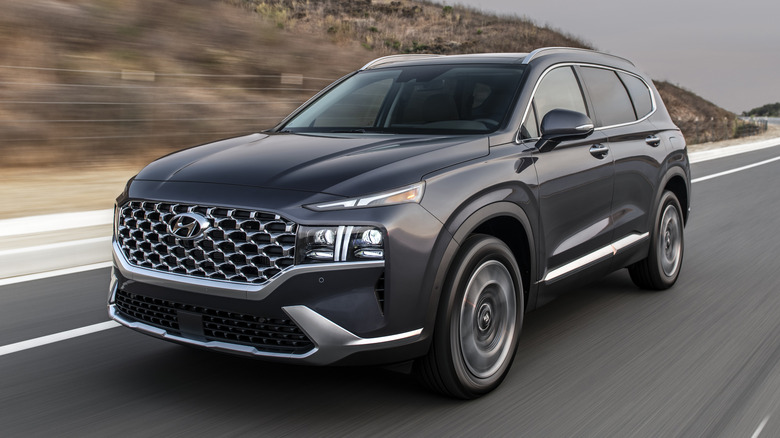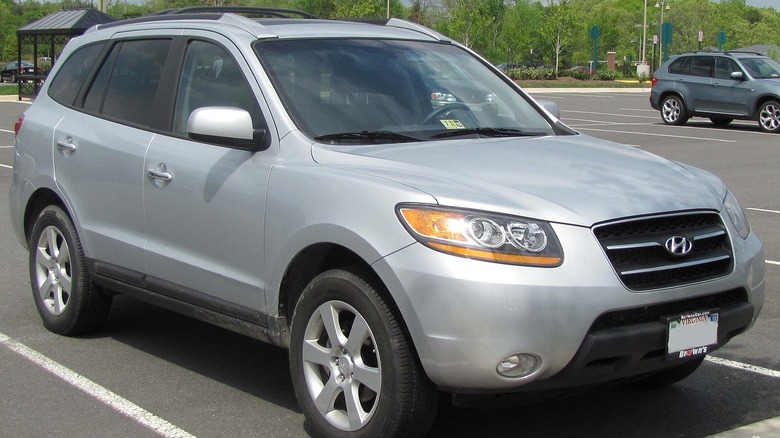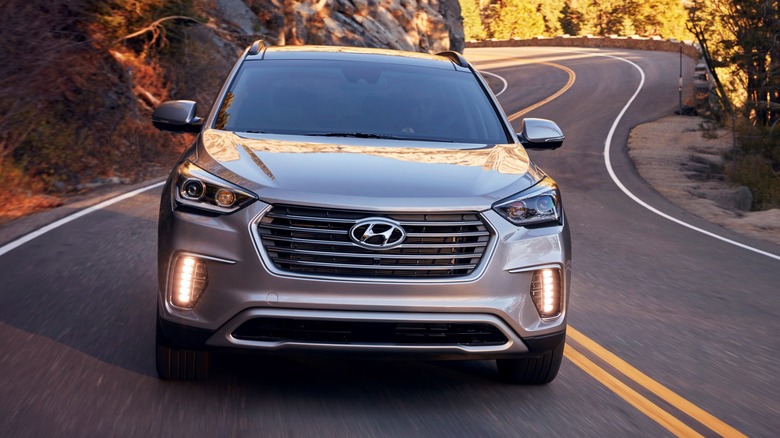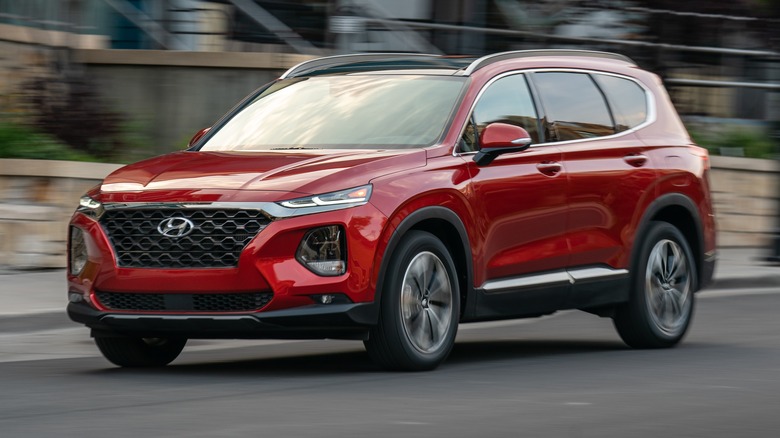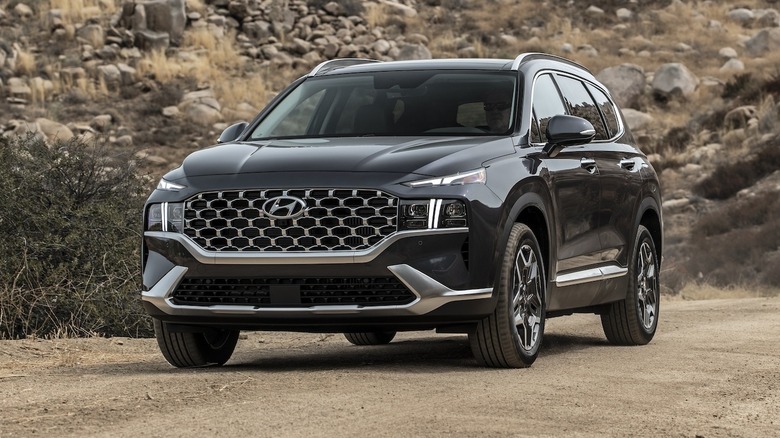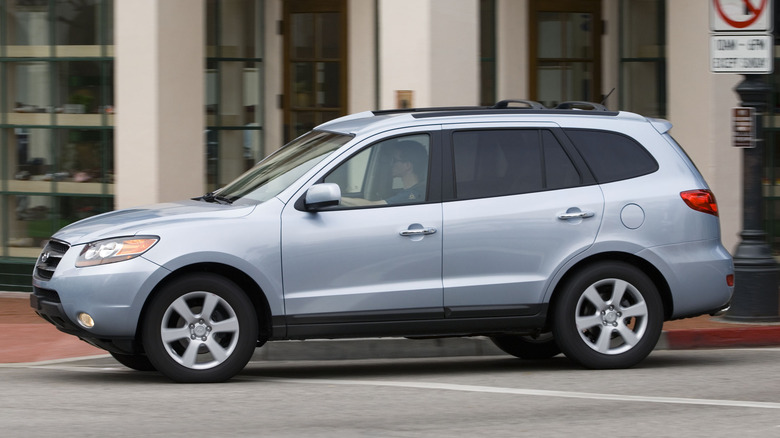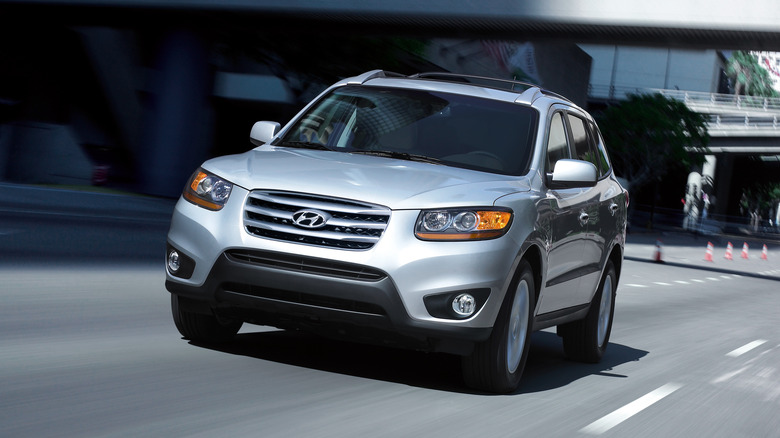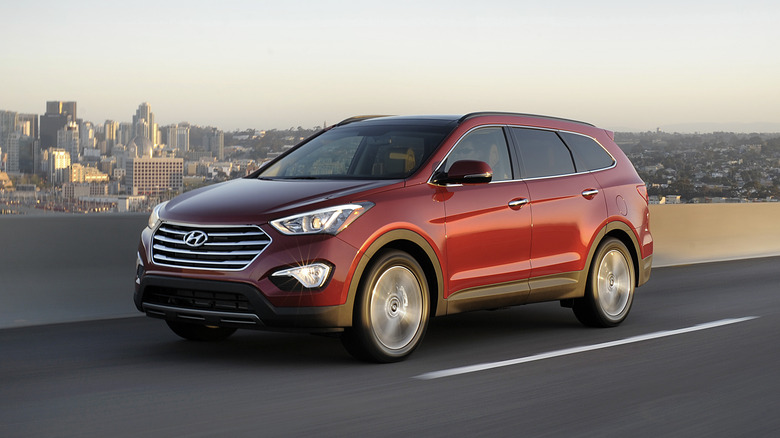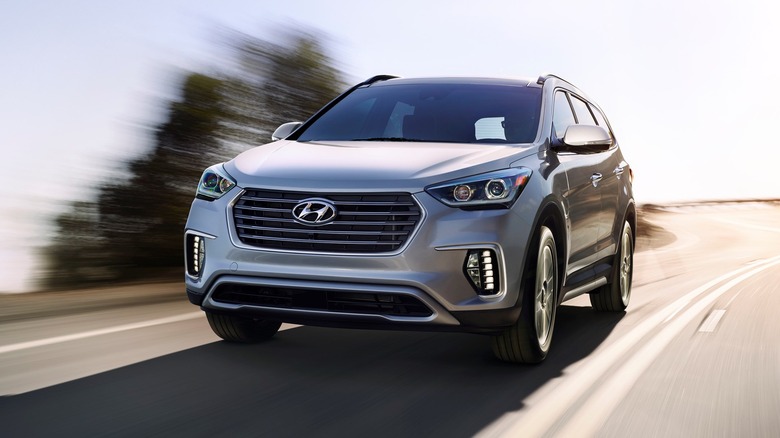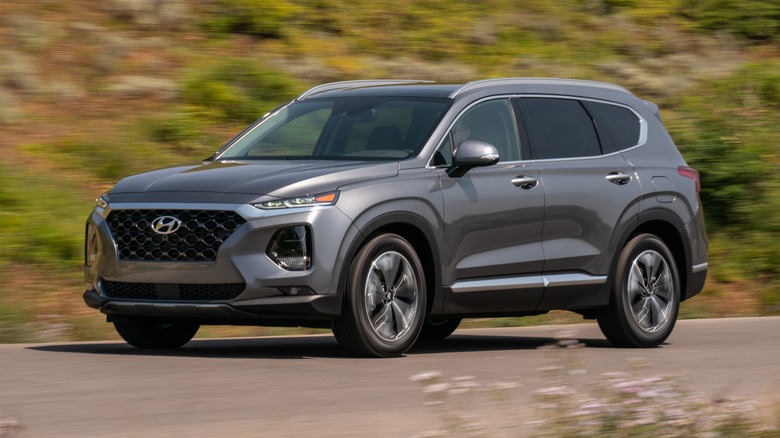The Best Years For The Hyundai Santa Fe, And Some To Avoid (According To Users)
Only one vehicle produced by Hyundai currently cracks the list of the 15 best-selling vehicles in the United States, and that would be the Hyundai Tucson, the company's signature crossover SUV. No other Hyundai even makes the top 25. Even though it may not be as popular as its smaller companion, the mid-size crossover Santa Fe from the Korean automaker has been remarkably steady in its sales over the years, regularly topping over 100,000 units sold in America per year. The Hyundai Santa Fe clearly has a large audience, and that audience is rightfully earned because it has been able to deliver a quality automobile for drivers for over two decades now.
Due to this, there are sure to be many people wanting to get a Santa Fe on the used market, eschewing the hefty prices and natural unpredictability of its longevity that comes with a new vehicle. While the word on the Hyundai Santa Fe has been generally positive for a long time now, that does not mean every year the SUV was produced was it at its best. The Santa Fe has had some down years in its life, and here, we are going to spotlight four model years that would make for great options for your used vehicle needs. Plus, four years that would be best to steer clear of.
In order to select which four model years will represent these two sides of the coin, we have looked to the opinions of actual owners of the Santa Fe to see which model years rate the highest and lowest based on their firsthand experience, which have pooled together from a variety of different sources.
Best: 2009 Santa Fe
For the first model on the list, we are going to rewind the clock back to the 2009 Hyundai Santa Fe. This particular model falls at roughly the midpoint of the SUV's second generation that began with the 2007 model. The first generation of the Santa Fe was actually a compact crossover, and with this new one, Hyundai increased the size. This not only made it a mid-size crossover, but it also allowed for a third row of seats best suited for small children. This update came with some issues initially, which we will get to later in this article, but by 2009, customers were quite impressed with what this version of the Santa Fe had to offer.
The customers on Edmunds have given the 2009 model an average of 4.4 out of five stars, citing the spaciousness, their driving experience, comfort, and safety as some of its best qualities. The praise doesn't stop there, as the drivers on Kelley Blue Book and Cars.com each have given the Santa Fe an average of 4.6 stars. Although it isn't as high as these averages, the owner satisfaction score from Consumer Reports is a solid three out of five, which does not utilize decimal points in its ratings.
Something you especially like to see with a vehicle that is now over 15 years old since it debuted is that there have only been three recalls issued for the 2009 Santa Fe in that time. That shows that Hyundai was building this thing with care. Clearly, this was a good year for the Santa Fe.
[Featured image by IFCAR via Wikimedia Commons | Cropped and scaled | Public Domain]
Best: 2018 Santa Fe
Back for the 2013 model year, Hyundai bifurcated the Santa Fe. On the one hand, you had the traditional Santa Fe that had been around, but the company also created the Santa Fe Sport, a two-row, compact version of the SUV. During this era, the Santa Fe had some down years, including multiple years when it received a one out of five owner satisfaction score from Consumer Reports. However, by the time it got to the 2018 model year — the last year of this generation and the one getting our recommendation — Hyundai was back to making a high quality machine.
The consumers over on Cars.com have the highest praise for the crossover, giving it an impressive overall average of 4.7 out of five stars. Meanwhile, those who rated and reviewed their 2018 Santa Fe on Kelley Blue Book and Edmunds are slightly lower with their averages, each site having a 4.2-star rating, but those are still high quality numbers. J.D. Power also awards the crossover with very good marks, giving it an overall score of 81 out of 100 with a quality and reliability score of 82.
What is most impressive about the 2018 Santa Fe is just how few reports of problems there are with it. Overall, it has only been issued two recalls in its time, and in a rather staggering surprise, there have been just five submitted issues on CarComplaints from drivers. There are model years that surpass 100. Hyundai nailed the end of this Santa Fe generation.
Best: 2019 Santa Fe
Even though the 2018 model was a high, it was time for the Hyundai Santa Fe to undergo some upgrades for a new generation. In another branding realignment, Hyundai decided to drop the Santa Fe Sport. However, what this meant in practice was that the Sport was now to become just the Santa Fe, meaning that it now just featured two rows of seats. If you wanted that third row, you would need to get a Santa Fe XL. Even though some people missed that third row, the 2019 Santa Fe has received some of the highest marks that any model year of the Hyundai has received from drivers.
On the low end of the spectrum, you have the consumer ratings on Edmunds, which have given it an average score of 4.3 stars out of five. When that is the low end of the spectrum, you know you are in good hands. One step up from that is the 4.4-star average from drivers on Kelley Blue Book, though it should be noted that the experts rating there is 4.7 stars.
Regardless, the praise at Cars.com is even higher, giving it an average score of 4.8 stars. To get a score that high, you may think it's just a few reviews, but over 200 owners have rated the 2019 model there. The drivers from J.D. Power give it an overall score of 84 out of 100, including a quality and reliability score of 86. This generation of the Santa Fe couldn't have gotten off to a better start.
Best: 2023 Santa Fe
The generation that began with the 2019 model came to a close with the 2023 Hyundai Santa Fe, and that will be the final recommendation on this list for a used vehicle. Despite being from the same generation, a lot had changed for the crossover in that time period. Most notably, you were now able to get the Santa Fe with a hybrid powertrain, along with upgrades to the engines, interior, and technological features like pedestrian detection that came standard issue. Even though this is still a fairly new vehicle, Hyundai started a new generation for the Santa Fe for 2024 — including reinstating the third row of seats — which makes this already feel like something of a top-notch throwback.
Edmunds, Kelley Blue Book, and Cars.com are all within the same narrow range when it comes to each site's average rating from drivers, earning 4.3, 4.4, and 4.5 stars from those customers respectively. The experts on Kelley Blue Book are even higher at 4.7 stars. This is the only model year for the Santa Fe since the introduction of the hybrid powertrain to earn the "CR Recommended" stamp of approval from Consumer Reports. Over at J.D. Power, it has an overall score of 82 out of 100, earning an 83 for quality and reliability and an 82 for driving experience. We here at SlashGear even gave very positive reviews to both the standard Santa Fe and the plug-in hybrid version as well. If you want the appearance and sheen of a new vehicle without it actually being new, the 2023 Santa Fe is worth it.
Avoid: 2007 Santa Fe
There are always risks when buying a new generation car model. After all, this is a whole new machine, and it comprises so many parts that some of them may not work in the way the manufacture hoped. Unfortunately, the second generation of the Hyundai Santa Fe that began with the 2007 model year learned that the hard way. Not only is this one of the worst years for the crossover SUV, but it is one of the models you really should avoid at all costs out of any Hyundai.
This is because there have been a substantial amount of problems' drivers have faced with this model. Out of any model year for the Santa Fe, 2007 is the one with the most submitted issues from people on CarComplaints. This is coming off of a first generation that relatively went about its time with a steady, fairly average number of issues per year. The number one issue drivers have encountered with it is a malfunctioning fuel gauge.
Knowing how much fuel is in your tank is of paramount importance if you don't want to be randomly stranded on the side of a road because you ran out of gas. Despite being recalled nine times for issues ranging from malfunctioning airbags to short-circuiting trailer hitches to fuel leaks, none of them corrected this fuel gauge problem, leaving it up to mechanics. That burden should not be on the driver.
Avoid: 2012 Santa Fe
When a generation of a vehicle gets to its final year, it is either at one of two places. On the one hand, the automaker has perfected this version of the vehicle to the point that the only way for it to evolve is to radically change things up. On the other, you have the generations that end on a bum note, leaving the people wanting something different and better.
Unfortunately, the latter is what happened with the generation that ended with the 2012 model year, which would lead to the splitting of the Hyundai Santa Fe and the Santa Fe Sport. Although the overall number of published problems with this vehicle reach the 2007 model, the 2012 Santa Fe's issues were arguably worse and more costly to fix, leading CarComplaints to rate this as the worst model year for the vehicle of all.
The reason for this is quite simple. The number one issue that this model year faced was that a substantial number of drivers faced engine failure. Fixing an engine — or getting a new one entirely — is one of the costlier endeavors that a car owner can encounter with a mechanic. CarComplaints estimates the average cost of this repair to be $5,100. Considering the average price for a 2012 Santa Fe is typically in the range of $5,500 to $7,050, that is an even more absurd thing to get fixed after buying a used model. Unless you want the possibility of a significant financial headache, there is little reason to go for a 2012 Santa Fe.
Avoid: 2013-2014 Santa Fe
If the previous generation ended on a whimper, you would hope that the one that succeeds it will come in on a high note. However, with the Hyundai Santa Fe, that was not the case. For the first two years of this new generation, in 2013 and 2014, it was plagued with many of the same issues that the previous model had endured. In fact, 2013 had even more reported issues on CarComplaints than the already poor 2012 model. One might imagine that this transition would replace old problems with new ones, but with the Santa Fe, it was still the engine causing trouble.
With the 2013 and 2014 models, engine failure was still the most frequently cited problem on CarComplaints from drivers. It is rather remarkable that a car company, particularly one as generally reliable as Hyundai is, had three straight years where a vehicle's engine was prone to failure or stalling. You might think that because of the Santa Fe and Santa Fe Sport split that all of the focus went to the new Sport model to make sure its engine ran fine, but the 2013 and 2014 models of the Santa Fe Sport also have engine failure as their number one issue on CarComplaints.
Consumer Reports backs up this poor reliability as well, with the 2013 model getting a 22 out of 100 reliability score. 2014 was much better at 27, and this year also received a one out of five owner satisfaction rating. This generation couldn't have started out worse.
Avoid: 2017 Santa Fe
For the last model year that you can avoid on the used car market, we look to the 2017 Hyundai Santa Fe. This is the other model year that appeared on SlashGear's list of most avoidable Hyundai's alongside the 2007 one, and it is not difficult to understand why that would be the case. With the 2016 model, the issues that had been affecting this generation that began with the aforementioned 2013 and 2014 models were largely gone, leading to a drastic decrease in submitted complaints from drivers on CarComplaints. Unfortunately, those complaints shot back up again when the 2017 Santa Fe came around. This year saw substantial technological upgrades, particularly for the infotainment features in the car, but this is not where people were having issues.
Instead, the two biggest areas of problems were with the engine and the transmission. Once again, a Hyundai Santa Fe engine has a significant number of reports of failure or stalling. That being said, the engine complaints are outdone by the transmission complaints, which primarily have to deal with hesitation while trying to accelerate. It is never a good sign when the sole solution that CarComplaints has recommended for this issue is "not sure." Even if it is an expensive fix, you want there to at least be a way to fix it and not just be met with a shrug. If you want to avoid a potential expensive engine replacement and a poorly made transmission, then stay away from the 2017 Santa Fe.
Methodology
While the methodology to select the eight Hyundai Santa Fe model years that would make this list may have been seemingly quite simple, it required an extensive dive into the opinions of actual Santa Fe drivers to find their true consensus opinions. This is why many sources were used to find as broad of a spectrum as possible. This included pulling together the average customer ratings from Consumer Reports, Edmunds, J.D. Power, Kelley Blue Book, and Cars.com. Consumer Reports and J.D. Power, in particular, were important places to determine what people thought about the quality and reliability of the vehicle, which is arguably the primary factor of why someone would choose one used automobile over another.
To find the bad in these Santa Fe models, a source like CarComplaints was paramount, which is where drivers can specifically document what exactly is wrong with their vehicle, how many miles it took for it to happen, and the average price to fix these issues. Also, the number of recalls a particular model year was issued was taken into consideration. Combine all of this together, and you have four recommendations for a used Hyundai Santa Fe and four recommendations for what should stay on the lot.
